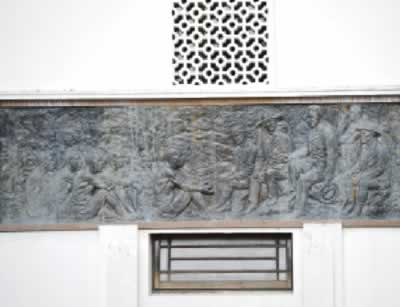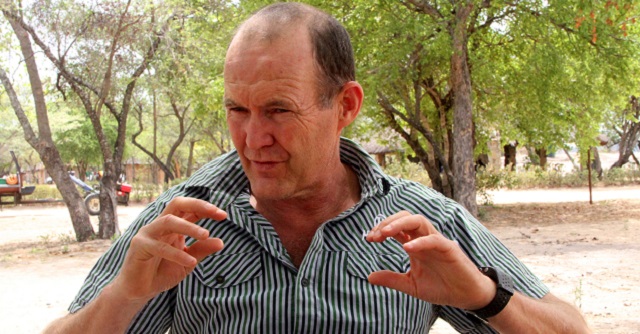
The Sunday News

WITH pressure mounting over the continued preservation of artefacts in remembrance of colonialist Cecil John Rhodes, questions have been raised over the Bulawayo City Council’s resolution to uncover a plaque that is seen to demean black Zimbabweans.
The plaque which is located at the main entrance of the City Hall’s municipal office was uncovered in June 2010 after a resolution was passed by the local authority, noting that this was “part of history that had to be celebrated”.
In the plaque, Rhodes is depicted seated on a higher rock, seemingly addressing the Ndebele chiefs who are seated on the ground, in what has been said to have been peace negotiations.
According to the local authority, the Indaba plaque has historic significance for the history of Bulawayo and ushered in a different era in the history of the people of Bulawayo, hence the resolution to open it after it had been under by a wooden cover with people complaining that it was demeaning and portrayed Africans as bowing down to Rhodes’ leadership.
The uncovering of the plaque came at a time when Government, through the National Museums and Monuments of Zimbabwe (NMMZ) on 14 August 1980 ordered the removal of Rhodes’ statue which was situated at the intersection of Main Street (now Joshua Mqabuko Nkomo) and 8th Avenue. The statue is now located outside the Bulawayo museum.
“The Memorial Rhodes/ Matebele Indaba plaque bronze panel outside the doorway of the City Hall (Municipal Offices), depicts the first Indaba held on 21 August 1896 between Cecil Rhodes and the Matebele in the Matopos when peace was made with the Matebele. Mr Rhodes was accompanied by Dr Hans Sauer, Colonel Johan Colenbrander and Mr Vere Stent. The Matebele/ Ndebele were led by Chief Somabulane.
“The Indaba plaque was designed by Professor F W Armstrong, University of Witwatersrand and cast by Signor R Vignali, Pretoria. It was unveiled by Lady Stanley on 4 November 1940 and the ceremony was attended by Mr Vere Stent and five of the Africans who had been present at the Indaba, the Indaba Plaque had the wooden cover removed following a Council resolution of 2nd June 2010,” said the council’s senior public relations officer, Mrs Nesisa Mpofu.
In defending the importance of the plaque, Mrs Mpofu said it symbolised the ushering in of a different era in the history of the people of Bulawayo.
In an interview with Sunday News, National Museums and Monuments of Zimbabwe director Dr Godfrey Mahachi said while such artefacts symbolised a part of the country’s history there was no need to celebrate Rhodes as a figure.
“What Zimbabwe did after attaining its independence was to pull down Rhodes’ statues as acknowledgement of the fact that we were not going to celebrate or associate with Rhodes’s figure.
“However, we cannot pretend that this history does not exist; if there are places that remind us of these times they should be known. It is not like we are celebrating colonialism but we are simply acknowledging our history,” said Dr Mahachi.
Questioned on the logic of covering then later uncovering of the plaque, Dr Mahachi said this was more of a resolve by the local authority to acknowledge a part of the country’s history.
“I don’t think it’s about tourism or celebrating the life of Rhodes and I don’t believe the council uncovered the plaque in bad faith but it’s all about acknowledging a part of our history,” said Dr Mahachi.
However, various academics and independent analysts have added to the debate surrounding the plaque and the exhumation of Rhodes’ grave at the Matopo hills, lambasting the local authority for celebrating conquest.
National University of Science and Technology lecturer and University of Johannesburg Post doctorate fellow, Dr Shepherd Mpofu said colonialism was all about subjugation and images such as the Indaba plaque represented this subjugation.
“We can protect the memorials in the museums where those with interest may go and see them, the argument that preserving colonial statues and symbols in the public landscape helps preserve history is not only flawed but strange. “The artefacts are and were signifiers of conquest and domination, their presence serves that purpose. The West views them and makes pilgrimages to these places not with a mindset that there is a new dispensation but in celebration of their ancestors’ conquest.
We, on the other hand see it as continual emasculation,” said Dr Mpofu.
He said for Zimbabwe to attain total independence they had to push for other freedoms that included decolonising the public space.
“The bottom line is some of these things have to be done in the process of nation-making. We can take the plaques to museums. We cannot preserve monuments of our castration all in the name of history and tourism,” said Dr Mpofu.
Another independent analyst Mr Khanyile Mlotshwa accused BCC of investing a lot of money towards the celebration of conquest, which included last year’s 120 years celebrations which he said symbolised Rhode’s conquest of Bulawayo.
“It must be stated that Matabeleland, and specifically Bulawayo, as it exists today is a manifestation of a colonial dream, Cecil John Rhodes’s dream, built upon the conquered dreams of our ancestors. So much attest to that especially Rhodes’ grave in Matopos, the insulting colonial triumphalist piece of art above the City Hall’s entrance to the council chambers, and the fact that last year the Bulawayo City Council invested so much in celebrating 120 years since King Lobengula’s Bulawayo was replaced by Cecil John Rhodes’s Bulawayo.
“Talk about tourism ignores the fact that none of the people of Matabeleland have benefited from money linked to the presence of those bones at our spiritual mountain. It is also for that reason that the piece of art work at the City Hall must be removed and replaced with something that speaks of our independence,” said Mr Mlotshwa.
He said people could still acknowledge that these Rhodes artefacts were part of our history when they are far from the public domain.
“The BCC, and all those who call themselves our leaders in whatever capacity, should start investing in joining the subaltern of Matabeleland in celebrating the Rozvi rulers of Khami, celebrating Kings Mzilikazi and Lobengula Khumalo and Queen Lozikeyi and other queens silenced by history, reflecting on the fall of the Matabeleland people at the banks of Tshangane river.
“Rhodes should not be allowed to mess Matabeleland even in death. As the architect of both South Africa and Zimbabwe, Rhodes continues to haunt us in many practical ways today, we need deeper reform and transformation, and that starts with deconstructing the symbols associated with the architect of this coloniality that we are caught up in. For that reason, and just as the stone birds stolen from Great Zimbabwe flew back home, Rhodes should also go back home to England in every sense,” said Mr Mlotshwa.
However, Prince Peter Zwide-Ka-Langa Khumalo, a descendant of King Lobengula said it was mere activists’ emotions to want to remove either the plaque or exhume Rhodes’ remains noting that these were an important part of our history that had to be preserved.
“If we remove that plaque because it reminds us of Rhodes then why don’t we go around destroying all the buildings in the city that were built during the colonial regime. I view this as mere activists’ emotions because we just cannot go around removing plaques and digging up graves.
“Those who are saying this plaque should be taken to the museum should think what role it will play at the museum which is different from the role it is playing at the city hall; this plaque represents a part of history of Zimbabwe and the Ndebele in particular,” said Mr Khumalo.
He said it would be folly for people to want to break the history of the country all in the name of activism.
The latest debate on artefacts meant as remembrance to Rhodes comes after South African students at the University of Cape Town staged protests a couple of weeks ago that led to the removal of Rhodes’ statue from the campus.
Zanu-PF activist and former commissar for Masotsha Ndlovu district, Cde Zweli Malinga, was recently quoted in the media arguing that Rhodes’ grave also had to be exhumed and his remains repatriated to England as the grave was a symbol of celebrating white colonialism. In 2012, Government blocked plans by war veterans to exhume Rhodes’ grave and return his remains to the United Kingdom, saying his legacy was part of the national history.
The war vets blamed drought and the dry spell in some parts of the country on Rhodes’ grave, saying if his bones were returned, the country’s fortunes could change.
Cde Cain Mathema, then Bulawayo governor and now Matabeleland North Provincial Affairs minister, supported this argument, saying Rhodes’ remains were to blame for the lack of rains in Matobo.



